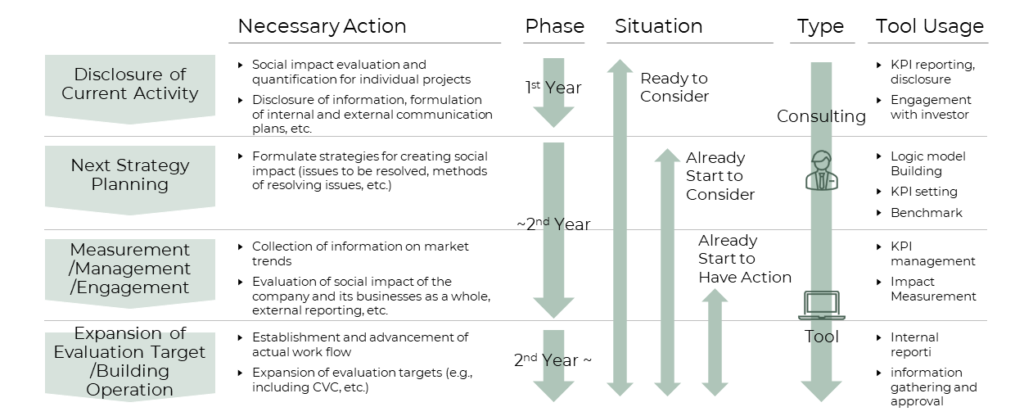Related to the following themes:
Understanding the Practical Applications of Impact Management in Business Companies.
Understanding the Practical Challenges of Impact Management in Business Companies.
Imagining the Concrete Steps Towards Establishing an Ideal Impact Management Framework
The Importance and Utility of Impact for Companies
Conscious management and business activities focused on impact maximize sustainability for both companies and society, achieving ‘enhanced engagement’ and ‘sustainable business growth,’ ultimately leading to continuous improvement in corporate value. Impact is increasingly becoming a matter of consideration in decision-making at the management level, with its significance and relevance rapidly expanding, as evident in recommendations from organizations like Keidanren (Japan Business Federation). Moreover, its relevance and significance extend beyond the realm of top management, offering meaningful applications and value for individual departments.
| IR/Finance Department | Lowering capital costs and acquiring new funding sources (Improving dialogue with investors) |
| Sustainability Promotion Department | Enhancing employee motivation and commitment (Visualizing the purpose of the company and the social significance of its business) |
| Human Resources Department | Organizing a new evaluation system for employees (Visualizing and returning the impact through business) |
| Business/R&D Department | Implementing innovation investments for medium and long-term growth (Evaluating activities, businesses, and themes based on impact) |
| New Business Development Department/CVC | Accelerating business growth and open innovation (Involving communities, companies, and talent with an emphasis on empathy) |
| Management Planning/Top Management | Restructuring the business portfolio (Evaluating companies and businesses based on a new value axis centered on impact) |
Key Challenges Regarding Impact in Companies
As mentioned earlier, impact is no longer just a part of corporate strategy and business activities but something that requires comprehensive and conscious management throughout the organization. However, aligning internal and external perceptions of the impact a company generates and coordinating efforts related to strategies and impact is not a straightforward task.
Differences in the framework and granularity of perspectives on sustainability between ESG promotion departments and business departments make it challenging to ensure coherence as a single strategy.
Business planning departments, ESG promotion departments, etc.
While understanding that ESG provides a checklist-like and common framework that is easily accepted by investors, there is a desire to convey our company’s or business’s appeal and contributions to society more directly.
Business departments, strategic planning departments, etc.
A large amount of quantitative and qualitative information is required for external communication related to ESG. However, understanding is not obtained from the business departments or strategic departments.
IR departments, ESG promotion departments, etc.
The utility of impactlake™
In order to address these challenges, impactlake™ covers the processes of impact assessment and management that companies require. It aims to streamline and enhance engagement and disclosure, with a focus on interactions with investors and appealing to internal stakeholders. Furthermore, it offers more than just data collection and aggregation; it provides a framework and workflow for managing impact across the entire organization, emphasizing the importance of impact management. Specific functionalities include:
- Collecting impact investment information from investors, stakeholders, and competing companies
- Selecting and setting KPIs, KPI reporting, and centralization and management (deadlines, reporting content, etc.)
- Organizing the impact model (logic model) that the company addresses
- Quantifying the impact created by the company or the potential impact
- Creating external reports (sustainability reports, etc.)
- Internal management and inner branding
- Continuous data collection and data retention
The Achievement Image of Impact Management
Simply providing tools and carrying out activities won’t automatically lead to achieving the goal. In reality, it’s essential to consider what kind of impact the company aims to create and how to align it with the overall strategy to ensure effectiveness that contributes to improved performance and corporate value. At IMPACTLAKE, we highly recommend thorough consideration and collaboration on these aspects through our consulting services. On the other hand, the ESG/sustainability trends are irreversible and long-term, and they require a practical, long-term perspective. That’s why IMPACTLAKE can support the step-by-step implementation of these practices in a comprehensive manner (whether self-implemented or externally), providing multifaceted assistance to achieve your goals.

Exploring and Utilizing Impact Management
In the practical realm of impact management and impact accounting, publicly available information is still limited. IMPACTLAKE strives to systematically organize methodologies, case studies, and tips, making them as comprehensive as possible. We encourage you to make use of this information. Furthermore, for those considering the establishment of a structure and workflow to maximize the use of these resources and to continue creating value consistently, please don’t hesitate to contact us.
Additional Knowledge on Impact Management and Impact Accounting can be found here.
If you are considering utilization, please feel free to contact us.
